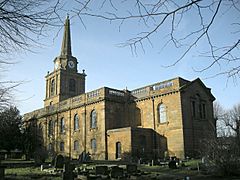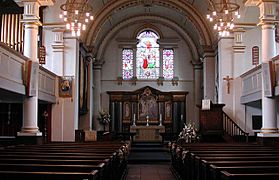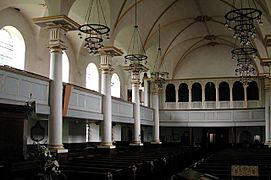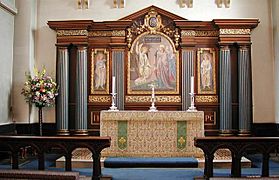Holy Cross Church, Daventry facts for kids
Quick facts for kids Holy Cross Church |
|
|---|---|
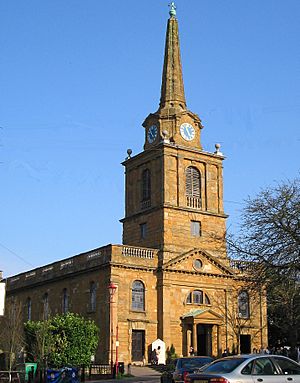
Holy Cross Church, Daventry
|
|
| 52°15′30″N 1°09′33″W / 52.258264°N 1.159160°W | |
| Location | Church Walk, Daventry, Northamptonshire, NN11 4BL |
| Country | England |
| Denomination | Church of England |
| History | |
| Status | Active |
| Architecture | |
| Functional status | Parish church |
| Heritage designation | Grade I listed |
| Years built | 1752–1758 |
| Administration | |
| Diocese | Peterborough |
| Province | Canterbury |
The Church of Holy Cross is a very old and important church in Daventry, Northamptonshire, England. It's special because it's the only church in Northamptonshire built in the 1700s that is still used as a town church. It's also a Grade I listed building, which means it's a really important historical site.
Contents
History of Holy Cross Church
Little is known about the very first church on this spot. It was probably there around the time of the Norman Conquest in 1066. This was when William the Conqueror took over England.
Early Church and Priory
Around 1108, a small Cluniac priory was started next to the church in Daventry. A priory is like a monastery where monks live and pray. This priory was closed in 1526 by Cardinal Wolsey. He was a powerful church leader. He gave the priory's money and property to Christ Church, Oxford, a famous college.
Building the Current Church
The church you see today was built between 1752 and 1758. It was designed by two brothers, William and David Hiorne. They were architects and builders from Warwick. Building the church cost £3,468. This money was collected from people who wanted to help. The old church was falling apart and wasn't safe anymore. The new church's design was inspired by St Giles in the Fields church in London.
Other Churches in Daventry
For a while, Holy Cross was not the only Church of England church in Daventry. There was another church called St James. It was built in 1839 by an architect named Hugh Smith. St James church was located on the east side of St James Street. However, it was taken down in 1962.
Architecture of Holy Cross
The church is built from a local stone called ironstone. The front of the church, on the west side, is wide. It has large, flat columns called pilasters at the corners and in the middle.
Church Features
The entrance porch was added in 1951. A tall, square tower rises from the middle of the church. On top of the tower is an obelisk spire, which is a tall, pointed monument.
Inside, the church has three wooden balconies, or galleries. These are on the north, south, and west sides. The pulpit, where sermons are given, is decorated with special wood patterns called marquetry and carved designs called fretwork. It has a staircase with twisted balusters, which are decorative posts.
Above the altar at the east end of the church is a beautiful stained glass window. It has three sections, like a Venetian window. There are also old family crests and symbols in the two upper west windows. You can also see old marble monuments on the walls inside the church. These were made in the 1700s and 1800s.
Keeping the Church Safe
In 2012, a report called the Heritage at Risk Register said that Holy Cross Church was well looked after. However, some of the ironstone blocks and limestone balusters high up on the church had worn away. The stone parts on the roof and balconies were a special worry. Some pieces of stone had even fallen off.
In December 2011, a grant was offered to help fix these problems. With this money, plus funds raised locally and a large gift from someone who wished to remain anonymous, repairs were done. The work took place between May and October 2013.
The Bells of Holy Cross
After 1550, a new Gothic-style church was built. In 1700, records show that five bells were hanging in its tower. Some of these bells were made by the Watts foundry in Leicester.
Recasting and Rehanging Bells
In 1738, these five bells, along with three others from Catesby Priory, were melted down and recast. This was done by Thomas Eayre from Kettering. He made them into a beautiful set of eight bells. The heaviest bell, called the tenor, weighed over 16 hundredweight (about 800 kg). These new bells were hung in the new tower in 1754.
Most of these bells stayed the same until 1908. The sixth bell was recast in 1764 by Joseph Eayre. In 1908, the tenor bell cracked badly and was recast by John Taylor & Co. In 1915, the seventh bell broke into two pieces during a Sunday service. It was also recast.
Modernizing the Bells
By 1938, the bells really needed to be rehung. The old wooden frame was made stronger. The bells were then hung on cast iron headstocks with ball-bearings, which made them easier to ring. In 1951, the third bell cracked and was recast.
In 1960, experts found that the bell frame was still moving a lot. This made the bells hard to ring, especially the tenor. The problem was that the ends of the huge wooden beams supporting the bells had rotted inside the walls.
The local bell ringers were very keen to fix this. They decided to install a frame for ten bells and add two new, smaller bells. At the same time, they decided to recast three of the old bells. The bell ringers even paid for two of them! The newly restored bells were officially dedicated in 1965. This happened when the Central Council of Church Bell Ringers visited Northampton.
Gallery


